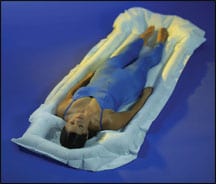Researchers at Orthomimetics of Cambridge, England have recently developed a joint replacement scaffold that encourages the joint bones and surrounding cartilage tissue to slowly regrow rather than relying on permanent metal replacement joints.
Based on new materials developed at Cambridge University and the Massachusetts Institute of Technology, the Orthomimetics procedure could greatly increase the quality of life and recovery time of patients formerly forced to rely on artificial joints.
Surgeons place the biodegradable scaffold made of the same materials as human cartilage (collagen and glycosaminoglycans) and bone (calcium phosphate) into the damaged joint area. Microscopic pores draw blood and stem cells into the scaffold. The stem cells mimic the materials around them, slowly transforming into cartilage and bone at the same time the scaffold slowly dissolves into the body.
The scaffold can also be filled with sterile fluids, blood products, or drugs such as pain killers or antibiotics for fast disbursement to the affected joint and the surrounding areas. Such products help speed recovery time and minimize side effects from the insertion surgery.
The collagen used in the Orthomimetics scaffold comes from the bovine Achilles tendon, a well tested medical source also used in skin and bone grafts, as well as in aesthetic surgery.
Glycosaminoglycans such as chondroitin sulphate, hyaluronan, and keratin sulphate are found naturally in the human body and can be introduced artificially without any negative reactions from the immune system. Because they are not typically subject to rejection, glycosaminoglycans taken from shark cartilage and other biologic sources are used in many surgical implants.
Calcium phosphates are a major component of bone and are currently used in bone graft procedures and as a coating for joint replacements. Most calcium phosphates used in medical products are synthetic laboratory products.
The Orthomimetics scaffold has been approved for use in Europe and is currently undergoing the FDA approval process in the United States. The company hopes full approval will be completed and the scaffold will be available to American patients within two years. Orthomimetics also hopes to develop scaffolds for regrowing tendons and ligaments in the near future.
[Source: The Future of Things]



